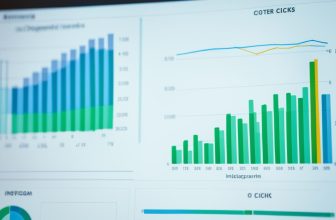The social media landscape is peppered with personalities who sway public opinion and inspire trends like never before. As the engine behind effective influencer marketing, these digital dynamos come in various forms, shaping the strategy for brands to reach their desired audiences. Understanding the different types of social media influencers is crucial for developing a robust social media influencer strategy. In this space, influencers are often segmented by the size of their followings—from the celebrity-status mega-influencers to the up-close-and-personal nano-influencers.
With influencer marketing surpassing an impressive $21.1 billion dollar market in 2023, it’s evident that businesses are investing heavily in tapping into the influencers’ power to reach consumers. The growth of this market, from $4.6 billion in 2018, underscores the vitality of these modern-day ambassadors in steering brand conversations and influencing consumer decisions.
Key Takeaways
- Influencer marketing has transformed into a multi-billion-dollar industry, indicative of its strong ROI potential.
- There are four primary types of social media influencers categorized by follower count: mega, macro, micro, and nano.
- An effective social media influencer strategy hinges on understanding the unique advantages of each influencer type.
- Mega-influencers have the widest reach, while nano-influencers offer the most focused and authentic engagement.
- Merging influencer partnerships with brand goals is essential for influential campaigns.
- A granular approach to influencer selection can lead to highly targeted marketing results.
Understanding the Influencer Marketing Landscape
The world of influencer marketing has evolved rapidly, turning digital spaces into dynamic platforms for influencer collaboration and campaigns. Becoming familiar with the intricacies of influencer marketing is key for brands aiming to enhance their visibility and connect authentically with their target audience.
The Rise of Influencer Marketing: From 2018 to 2023
In just half a decade, influencer marketing has transformed from a burgeoning niche into a dominant force in the digital marketing arena. The statistics speak volumes: a leap from a $4.6 billion industry in 2018 to a colossal $21.1 billion by 2023, signals not just growth but a profound shift in how brands approach marketing. This expansion reflects the increasing value placed on influencer-driven content as a means to engage and convert audiences globally.
How Industry Experts Define the Types of Social Media Influencers
Businesses and marketing strategists rely on a spectrum of influencer types, each suited to different marketing goals. This spectrum includes mega-influencers, with their extensive audience, to the nano-influencers, who offer highly targeted influence. Between these two poles lie macro and micro-influencers, deftly balancing reach and relevance. Their categorization provides a roadmap for crafting influencer campaigns that resonate with specific consumer segments.
Key Factors Influencing Influencer Collaboration and Campaigns
Several key factors underpin the strategy behind influencer collaboration. These include the authenticity of the influencer, the alignment of values between influencer and brand, audience demographics, engagement rates, and the nature of the campaign itself. A nuanced understanding of these dynamics enhances a brands’ capability to construct meaningful and impactful influencer campaigns. As businesses continue to invest in influencer marketing, recognizing these factors will be paramount in leveraging the full potential of a robust social media influencer strategy.
The Core Categories of Social Media Influencers
The landscape of influencer marketing is intricately segmented into various types of social media influencers, each with a unique spectrum of influence and engagement capabilities. Understanding these core categories is pivotal for any brand aiming to harness the power of influencers for their marketing strategies.

At the top, mega-influencers boast an impressive following, typically in the millions. Their vast reach is paralleled by global celebrities and can propel a brand into the limelight. Conversely, at the grassroots level, nano-influencers might have less than 1,000 followers, but their community influence and high engagement rates are invaluable for localized campaigns.
In between these two extremes lie macro-influencers and micro-influencers. The former enjoys followings between 100,000 and one million and are often known for their expertise in a particular niche. The latter, with followers ranging from 1,000 to 100,000, offer brands a sweet spot of targeted reach and robust engagement, often fostering close-knit community feels.
Undoubtedly, successful influencer marketing hinges on the alignment between a brand’s objectives and the chosen influencer’s type, reach, and authority.
- Mega-influencers: Ideal for wide-reaching awareness campaigns
- Macro-influencers: A balance of reach and relevance, suited for both awareness and conversion-oriented goals
- Micro-influencers: High engagement, perfect for niche targeting and community-driven interaction
- Nano-influencers: Exceptional for authentic, trust-building campaigns within highly specific audiences
Each type of social media influencer carries a distinct set of strengths, aligning with varied strategic goals for influencer marketing. Whether aiming for broad exposure or deepened niche connections, the integration of influencers into marketing campaigns has become an undeniable trend in the digital era.
What Embodies a Mega-Influencer?
In the dynamic realm of influencer marketing, mega-influencers are the powerhouses who command an audience that rivals traditional celebrities. They are individuals who have risen to a status where their followers, often numbering in the millions, look to them not just for entertainment, but for cues on lifestyle and consumer trends. Understanding the essence of a mega-influencer requires a closer look at their role in marketing, the strategic alignment with brand objectives, and the tangible impact they can have on promotional campaigns.

The Role of Celebrity Influencers in Marketing Strategies
Celebrity influencers like Dwayne Johnson and Selena Gomez exemplify the mega-influencer archetype, leveraging their star power to become pivotal figures in marketing strategies. Their influence transcends beyond just high follower counts; they carry with them a celebrity allure that makes their endorsements resonate across a broad spectrum of consumers.
Aligning Mega-Influencer Reach with Brand Goals
Aligning the immense reach of a mega-influencer with brand goals is no small feat. The expansive reach provided by figures such as Kim Kardashian can amplify brand messaging to a global scale, but requires a strategic approach to ensure messaging resonates with the right audience subset and drives desired actions.
High Profile Cases: Mega-Influencers’ Impact on Campaigns
To illustrate the impact of mega-influencers within the marketing landscape, let’s consider their participation in high profile campaigns. Celebrities turned mega-influencers like LeBron James and Taylor Swift have endorsed products in campaigns that garnered immense media attention and consumer interaction, ultimately driving substantial ROI for the brands involved.
| Influencer | Follower Count | Niche | Estimated Charge Per Post |
|---|---|---|---|
| Cristiano Ronaldo | Over 200 million | Sports/Fitness | $2.3 million |
| Kylie Jenner | 150 million+ | Beauty/Fashion | $1.8 million |
| Will Smith | 40 million+ | Entertainment/Lifestyle | Varies by campaign |
Macro-Influencers: Bridging the Gap Between Fame and Niche
Occupying an influential space within the digital landscape, macro-influencers offer a unique blend of widespread appeal and specialized knowledge, making them particularly effective for influencer collaboration and influencer marketing initiatives. Unlike their mega-influencer counterparts, who dazzle with celebrity status, macro-influencers have carved out fame thanks to internet-based platforms, allowing them to cultivate a large yet engaged following that trusts their authenticity and relishes their content.
These influencers typically steer the conversation and trends within their specific niches, making them ideal for brands keen on tapping into particular demographics. Their reach, often upwards of 100,000 followers, provides a substantial platform that, when combined with their niche expertise, results in compelling and high-impact marketing campaigns.
- Reach and Engagement: Macro-influencers have the numbers to provide reach yet maintain a level of engagement that speaks to dedicated and authentic communication.
- Trust and Relatability: Their ascent to influencer status via digital content creation fosters a sense of trust and relatability that resonates with audiences.
- Cost-Effectiveness: Collaborating with macro-influencers can be more cost-effective than partnering with celebrities, while still delivering significant impact.
- Niche Authority: They often own a specific corner of content, whether it be fashion, tech, or wellness, positioning them as go-to sources within their realms.
Macro-influencers like Amy Jackson, with her stylish brand endorsements, and Ashley Galvin, known for her wellness and fitness advocacies, reveal the power of influential voices in carving pathways to diverse audience segments. This balance of reach and focus makes the macro-influencer a versatile and indispensable asset in the realm of influencer marketing.
As businesses design their marketing strategies, the inclusion of macro-influencers is increasingly seen as a fundamental step to ensure a campaign’s success. They are the key demographic conduits that not only bring visibility to a brand but also lend their credibility, driving consumer connection and business growth.
In essence, the value of macro-influencers lies in their ability to seamlessly blend broad appeal with niche-specific influence. They are the bridge in influencer marketing approaches that smart brands cross in order to reach their targeted markets while building lasting relationships with both customers and influencers themselves.
Micro-Influencers: Niche Experts Driving Engagement
The dynamic sphere of influencer marketing spotlights micro-influencers as pivotal contributors to niche-specific discourse and engagement. These individuals cultivate spaces where their expert insights resonate authentically with a dedicated audience.
Revered for their capacity to form close-knit community connections, micro-influencers have carved out their stand as trusted voices. Brands seeking to capitalize on this trust have turned to micro-influencers to spearhead influencer campaigns with aims of achieving impressive engagement rates and conversion metrics.
Adobe and Squarespace, among other forward-thinking companies, have recognized the intrinsic value that micro-influencers bring to the table, engaging them in campaigns that exude credibility and relevance.
Social media influencer strategy development necessitates an understanding of the unique position that micro-influencers occupy. Their followers consider them as more than just content creators; they are viewed as genuine advocates and connoisseurs in their respective fields. This level of esteem translates into a potent formula for high-impact influencer marketing.
- Expert knowledge within a niche
- Authentic connection with audience
- Increased engagement and high conversion potential
- Cost-effective partnerships for brands
- Strong return on investment (ROI) for marketing efforts
Ultimately, including micro-influencers in a brand’s social media influencer strategy not only enriches the campaign’s relevance but also assures a genuine discourse with prospective customers, forging a path to commercial success grounded in authenticity and expertise.
Discovering the Value of Nano-Influencers in Targeted Campaigns
At the cutting edge of influencer marketing lies a potent, albeit less conspicuous force: the nano-influencers. Characterized by their modest followings, these individuals are redefining what it means to have influence by leveraging their deeply personal community connections. Rather than casting a wide net, nano-influencers specialize in highly concentrated areas of influence, where authenticity is paramount and every like, comment, and share resonates deeply with their audience.
What nano-influencers lack in numbers, they more than compensate for with interaction rates that often dwarf those of their more prominent counterparts. This unparalleled level of engagement opens up opportunities for deeper, more meaningful influencer collaboration. These collaborations are imbued with a sense of trust and reliability that can only emerge from genuine, community-rooted connections. For brands, tapping into the devoted following of nano-influencers can be a strategic move towards reaching specific demographics with precision and authenticity.
The landscape of influencer marketing continues to shift as brands recognize the unique advantages presented by nano-influencers. These individuals prove that sometimes the smallest voices carry the most weight within their communities, driving brand narratives in ways that resonate on a personal level. As such, nano-influencers stand out as an invaluable asset for targeted campaigns, turning tight-knit group dynamics into a fertile ground for organic growth and engagement.
FAQ
The main types of social media influencers include mega-influencers with over 1 million followers, macro-influencers with 100,000 to 1 million followers, micro-influencers with 1,000 to 100,000 followers, and nano-influencers with fewer than 1,000 followers.
How has the influencer marketing industry grown from 2018 to 2023?
Influencer marketing has seen phenomenal growth, with the market expanding from .6 billion in 2018 to a projected .1 billion in 2023, thanks to the increasing effectiveness and popularity of influencer collaborations and campaigns.
Industry experts categorize social media influencers based on their follower count into four types: mega-influencers, macro-influencers, micro-influencers, and nano-influencers. Each category appeals to different target audiences and serves various strategic purposes in marketing.
What factors are important in influencer collaboration and campaigns?
Key factors include the influencer’s audience size and engagement levels, niche authority, alignment with the brand’s target demographic, the authenticity of their content, and the overall strategic fit within the brand’s marketing goals.
Who are considered mega-influencers and what role do they play in marketing?
Mega-influencers are individuals with over a million followers, often akin to celebrities. They play a significant role in marketing strategies by providing extensive reach and are typically used for brand awareness campaigns.
Why is it important to align a mega-influencer’s reach with brand goals?
Aligning a mega-influencer’s reach with brand goals is crucial because while they offer wide exposure, the diverse demographics of their audience may not always convert into sales. Strategic alignment ensures the influencer’s reach effectively contributes to the brand’s objectives.
Can you give examples of the impact of mega-influencers on campaigns?
Celebrities like Kylie Jenner can charge up to
FAQ
The main types of social media influencers include mega-influencers with over 1 million followers, macro-influencers with 100,000 to 1 million followers, micro-influencers with 1,000 to 100,000 followers, and nano-influencers with fewer than 1,000 followers.
How has the influencer marketing industry grown from 2018 to 2023?
Influencer marketing has seen phenomenal growth, with the market expanding from $4.6 billion in 2018 to a projected $21.1 billion in 2023, thanks to the increasing effectiveness and popularity of influencer collaborations and campaigns.
Industry experts categorize social media influencers based on their follower count into four types: mega-influencers, macro-influencers, micro-influencers, and nano-influencers. Each category appeals to different target audiences and serves various strategic purposes in marketing.
What factors are important in influencer collaboration and campaigns?
Key factors include the influencer’s audience size and engagement levels, niche authority, alignment with the brand’s target demographic, the authenticity of their content, and the overall strategic fit within the brand’s marketing goals.
Who are considered mega-influencers and what role do they play in marketing?
Mega-influencers are individuals with over a million followers, often akin to celebrities. They play a significant role in marketing strategies by providing extensive reach and are typically used for brand awareness campaigns.
Why is it important to align a mega-influencer’s reach with brand goals?
Aligning a mega-influencer’s reach with brand goals is crucial because while they offer wide exposure, the diverse demographics of their audience may not always convert into sales. Strategic alignment ensures the influencer’s reach effectively contributes to the brand’s objectives.
Can you give examples of the impact of mega-influencers on campaigns?
Celebrities like Kylie Jenner can charge up to $1.8 billion for a single post, reflecting the significant impact such mega-influencers can have on campaigns through their large followings and broad appeal.
What makes macro-influencers a valuable asset for brands?
Macro-influencers balance a large following with a sense of authenticity and relatability, making them valuable for brands looking to connect with a broader audience while maintaining niche appeal for more targeted marketing efforts.
How do micro-influencers add value to influencer campaigns?
Micro-influencers are valued for their subject matter expertise and ability to foster strong relationships with their audience, leading to high engagement rates and conversions. They are cost-effective partners for reaching specific interest groups with targeted messaging.
What distinctive benefits do nano-influencers offer in influencer marketing?
Nano-influencers offer high engagement levels and authenticity through their intimate connections with their communities. They are especially useful for brands wanting to make a genuine impact on a small and highly engaged audience, tapping into grassroots-level influence.
.8 billion for a single post, reflecting the significant impact such mega-influencers can have on campaigns through their large followings and broad appeal.
What makes macro-influencers a valuable asset for brands?
Macro-influencers balance a large following with a sense of authenticity and relatability, making them valuable for brands looking to connect with a broader audience while maintaining niche appeal for more targeted marketing efforts.
How do micro-influencers add value to influencer campaigns?
Micro-influencers are valued for their subject matter expertise and ability to foster strong relationships with their audience, leading to high engagement rates and conversions. They are cost-effective partners for reaching specific interest groups with targeted messaging.
What distinctive benefits do nano-influencers offer in influencer marketing?
Nano-influencers offer high engagement levels and authenticity through their intimate connections with their communities. They are especially useful for brands wanting to make a genuine impact on a small and highly engaged audience, tapping into grassroots-level influence.







